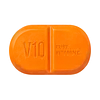What's inside
What's inside
 Key Ingredients
Key Ingredients

 Benefits
Benefits

 Concerns
Concerns

 Ingredients Side-by-side
Ingredients Side-by-side

Glycerin
HumectantWater
Skin ConditioningPropylene Glycol
HumectantSodium Palmitate
CleansingSodium Stearate
CleansingPotassium Laurate
EmulsifyingSodium Laurate
CleansingCoco-Betaine
CleansingDisodium Laureth Sulfosuccinate
CleansingSucrose
HumectantSorbitol
HumectantDecyl Glucoside
CleansingAscorbic Acid
AntioxidantNiacinamide
SmoothingStearic Acid
CleansingParfum
MaskingIlex Paraguariensis Leaf Extract
PerfumingPunica Granatum Extract
AstringentSchisandra Chinensis Fruit Extract
Skin ConditioningChamomilla Recutita Flower Extract
MaskingTricholoma Matsutake Extract
Skin ConditioningCitrus Limon Peel Oil
MaskingCitrus Reticulata Peel Oil
MaskingTocopherol
AntioxidantTocopheryl Acetate
AntioxidantCapsicum Annuum Fruit Powder
Skin ConditioningRosa Canina Fruit Oil
EmollientVitis Vinifera Seed Oil
EmollientFragaria Ananassa Fruit Powder
Skin ConditioningRiboflavin
Cosmetic ColorantCalcium Pantothenate
Inositol
HumectantFolic Acid
Skin ConditioningDisodium EDTA
Biotin
AntiseborrhoeicCyanocobalamin
Skin ConditioningLimonene
PerfumingLinalool
PerfumingGlycerin, Water, Propylene Glycol, Sodium Palmitate, Sodium Stearate, Potassium Laurate, Sodium Laurate, Coco-Betaine, Disodium Laureth Sulfosuccinate, Sucrose, Sorbitol, Decyl Glucoside, Ascorbic Acid, Niacinamide, Stearic Acid, Parfum, Ilex Paraguariensis Leaf Extract, Punica Granatum Extract, Schisandra Chinensis Fruit Extract, Chamomilla Recutita Flower Extract, Tricholoma Matsutake Extract, Citrus Limon Peel Oil, Citrus Reticulata Peel Oil, Tocopherol, Tocopheryl Acetate, Capsicum Annuum Fruit Powder, Rosa Canina Fruit Oil, Vitis Vinifera Seed Oil, Fragaria Ananassa Fruit Powder, Riboflavin, Calcium Pantothenate, Inositol, Folic Acid, Disodium EDTA, Biotin, Cyanocobalamin, Limonene, Linalool
O-Cymen-5-Ol
AntimicrobialDipotassium Glycyrrhizate
HumectantGum Base
Bentonite
AbsorbentKaolin
AbrasiveDextrin
AbsorbentCitric Acid
BufferingGlycerin
HumectantCharcoal
AbrasivePapain
Skin ConditioningAscorbyl Palmitate
AntioxidantButylene Glycol
HumectantWater
Skin ConditioningCI 77499
Cosmetic ColorantTocopherol
AntioxidantCopper Tripeptide-1
Skin ConditioningCeramide AP
Skin ConditioningParfum
Masking
 Reviews
Reviews

Alternatives
Ingredients Explained
These ingredients are found in both products.
Ingredients higher up in an ingredient list are typically present in a larger amount.
Glycerin is already naturally found in your skin. It helps moisturize and protect your skin.
A study from 2016 found glycerin to be more effective as a humectant than AHAs and hyaluronic acid.
As a humectant, it helps the skin stay hydrated by pulling moisture to your skin. The low molecular weight of glycerin allows it to pull moisture into the deeper layers of your skin.
Hydrated skin improves your skin barrier; Your skin barrier helps protect against irritants and bacteria.
Glycerin has also been found to have antimicrobial and antiviral properties. Due to these properties, glycerin is often used in wound and burn treatments.
In cosmetics, glycerin is usually derived from plants such as soybean or palm. However, it can also be sourced from animals, such as tallow or animal fat.
This ingredient is organic, colorless, odorless, and non-toxic.
Glycerin is the name for this ingredient in American English. British English uses Glycerol/Glycerine.
Learn more about GlycerinParfum is a catch-all term for an ingredient or more that is used to give a scent to products.
Also called "fragrance", this ingredient can be a blend of hundreds of chemicals or plant oils. This means every product with "fragrance" or "parfum" in the ingredients list is a different mixture.
For instance, Habanolide is a proprietary trade name for a specific aroma chemical. When used as a fragrance ingredient in cosmetics, most aroma chemicals fall under the broad labeling category of “FRAGRANCE” or “PARFUM” according to EU and US regulations.
The term 'parfum' or 'fragrance' is not regulated in many countries. In many cases, it is up to the brand to define this term.
For instance, many brands choose to label themselves as "fragrance-free" because they are not using synthetic fragrances. However, their products may still contain ingredients such as essential oils that are considered a fragrance by INCI standards.
One example is Calendula flower extract. Calendula is an essential oil that still imparts a scent or 'fragrance'.
Depending on the blend, the ingredients in the mixture can cause allergies and sensitivities on the skin. Some ingredients that are known EU allergens include linalool and citronellol.
Parfum can also be used to mask or cover an unpleasant scent.
The bottom line is: not all fragrances/parfum/ingredients are created equally. If you are worried about fragrances, we recommend taking a closer look at an ingredient. And of course, we always recommend speaking with a professional.
Learn more about ParfumTocopherol (also known as Vitamin E) is a common antioxidant used to help protect the skin from free-radicals and strengthen the skin barrier. It's also fat soluble - this means our skin is great at absorbing it.
Vitamin E also helps keep your natural skin lipids healthy. Your lipid skin barrier naturally consists of lipids, ceramides, and fatty acids. Vitamin E offers extra protection for your skin’s lipid barrier, keeping your skin healthy and nourished.
Another benefit is a bit of UV protection. Vitamin E helps reduce the damage caused by UVB rays. (It should not replace your sunscreen). Combining it with Vitamin C can decrease sunburned cells and hyperpigmentation after UV exposure.
You might have noticed Vitamin E + C often paired together. This is because it is great at stabilizing Vitamin C. Using the two together helps increase the effectiveness of both ingredients.
There are often claims that Vitamin E can reduce/prevent scarring, but these claims haven't been confirmed by scientific research.
Learn more about TocopherolWater. It's the most common cosmetic ingredient of all. You'll usually see it at the top of ingredient lists, meaning that it makes up the largest part of the product.
So why is it so popular? Water most often acts as a solvent - this means that it helps dissolve other ingredients into the formulation.
You'll also recognize water as that liquid we all need to stay alive. If you see this, drink a glass of water. Stay hydrated!
Learn more about Water